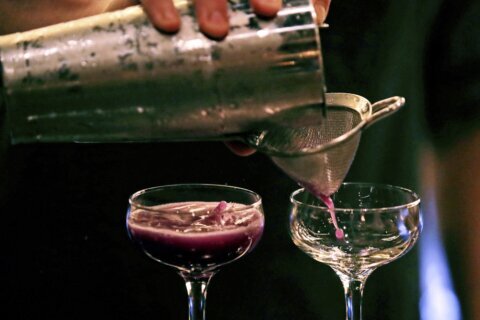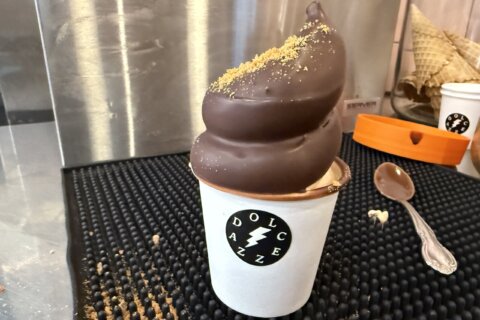WASHINGTON — In the evenings, the crowded and casual lunchtime spot GCDC undergoes a transformation.
The no-frills grilled cheese-and-tots menu is replaced by olives, cheese, charcuterie and a smaller selection of upscale sandwiches; the soups and sodas are swapped for craft beer, cocktails and wine.
And cheesemonger Sophie Slesinger brings a bit of theater to diners privy to an item not on the menu: fresh mozzarella.
“It’s literally the freshest mozzarella you can get,” Slesinger says. Seeing as how her mozzarella is made and balled to order, right in front of diners, she’s right.
Making Mozzarella at GCDC

She starts her process with a fermented mozzarella curd from Pennsylvania-based Caputo Brothers Creamery. They give the mozzarella a flavor that’s different from cheeses usually found at the grocery store.
Slesinger says when mozzarella is made in the U.S., it’s usually made with citric acid or lemon, a quick process that alters the final taste of the cheese.
“It has this milky, fresh taste; it doesn’t really have a very distinctive cheesy taste,” she says. “So by slow fermenting and by using real cultures, or bacteria, Caputo Brothers is creating this flavor in their curd that really isn’t present in any other mozzarella you can find. You’ll notice that when you taste this cheese curd, it’s so flavorful, it’s so cheesy; it really is that true, authentic Italian mozzarella.”

To make mozzarella, Slesinger scoops a few heaping spoons of the curd into a stainless steel bowl. Next, she generously seasons the curd with sea salt.
“It’s going to look like I’m going to put a lot of salt on here, because I am putting a lot of salt on here. But you’re not going to over-salt,” she says, explaining taht the salt will leach out in the process. “And you really do need it for flavor.”
Slesinger pours 190-degree water over the curds — just enough to cover them. Then she walks away for two minutes so the mozzarella can work its magic.

When she returns, she pushes all of the curds to one side of the bowl with the back of a wooden spoon. Then she adds a little more of the heated water, scoops the soaked curds up with her wooden spoon and holds the spoon in the air, letting half of the gooey mixture dangle off the edge. She lets gravity take over, and the cheese begins to stretch itself.
Slesinger says letting the cheese do the work, as opposed to pulling it, creates a lump-free, smooth and shiny finish. After she gets a good amount of “stretch,” she lowers the cheese back into the water and repeats the process.
Then, the cheese is worked into a baguette shape by a process Slesinger compares to “folding a ball of socks.” With her thumb and her forefinger, Slesinger squeezes the cheese into two balls before pinching it off into single-serving mozzarella balls.
“Impress your friends — have a pizza party,” she says.
Need a little guidance before attempting the cheesy challenge? Slesinger will teach a class on mozzarella-making Monday, Aug. 18, as well as a Cheese 101 class Monday, Aug. 25, at GCDC.
Follow @WTOP and @WTOPliving on Twitter and on the WTOP Facebook page.







